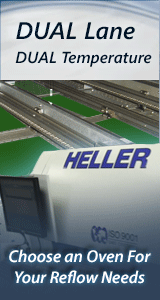Printed Circuit Board Assembly & PCB Design Forum
SMT electronics assembly manufacturing forum.
- SMTnet
- »
- Electronics Forum
- »
- THT manual assembly worker instructions
THT manual assembly worker instructions
Views: 9561
![]() Manual THT assembly (10 to 300 boards, 20 to 300 THT compone...
- Feb 23, 2008
by
schorschimi
Manual THT assembly (10 to 300 boards, 20 to 300 THT compone...
- Feb 23, 2008
by
schorschimi
![]()
![]()
![]() Some of our troop have poorly developed reading skills, beca...
- Feb 24, 2008
by
davef
Some of our troop have poorly developed reading skills, beca...
- Feb 24, 2008
by
davef
![]()
![]()
![]() Hi davef,
your comment is interesting.
Can you give de...
- Feb 24, 2008
by
schorschimi
Hi davef,
your comment is interesting.
Can you give de...
- Feb 24, 2008
by
schorschimi
![]()
![]()
![]() Skill and experiance level of assemblers is critical.
High ...
- Feb 24, 2008
by
Larry D
Skill and experiance level of assemblers is critical.
High ...
- Feb 24, 2008
by
Larry D
![]()
![]()
![]() We also used color coding of bins, along with a picture of w...
- Feb 25, 2008
by
PR
We also used color coding of bins, along with a picture of w...
- Feb 25, 2008
by
PR
![]()
![]()
![]() Search the fine SMTnet Archives on line balancing to find th...
- Feb 25, 2008
by
davef
Search the fine SMTnet Archives on line balancing to find th...
- Feb 25, 2008
by
davef
![]()
![]()
![]() There are various software programs out there to aid in the ...
- Feb 25, 2008
by
scotceltic
There are various software programs out there to aid in the ...
- Feb 25, 2008
by
scotceltic
![]()
![]()
![]() Poor reading skills......that being said, with good resoluti...
- Feb 25, 2008
by
Dirk Nuendyke
Poor reading skills......that being said, with good resoluti...
- Feb 25, 2008
by
Dirk Nuendyke
![]()
![]()
![]() the information on "slide lines" in this forum sounds fine, ...
- Feb 25, 2008
by
schorschimi
the information on "slide lines" in this forum sounds fine, ...
- Feb 25, 2008
by
schorschimi
![]()
![]()
![]() In that case the same tools can apply, just different implem...
- Feb 25, 2008
by
Steve Thomas
In that case the same tools can apply, just different implem...
- Feb 25, 2008
by
Steve Thomas
![]()
![]()
![]() Our people have EXCELLENT reading skills, and for some stuff...
- Feb 25, 2008
by
jmelson
Our people have EXCELLENT reading skills, and for some stuff...
- Feb 25, 2008
by
jmelson
![]()
![]()
![]() Does anyone still do Laser-Guided manual insertion?
Any m...
- Feb 26, 2008
by
Dirk Nuendyke
Does anyone still do Laser-Guided manual insertion?
Any m...
- Feb 26, 2008
by
Dirk Nuendyke
![]()
![]()
![]() here are two companies from Germany doing these machines.
...
- Feb 26, 2008
by
schorschimi
here are two companies from Germany doing these machines.
...
- Feb 26, 2008
by
schorschimi
![]()
![]()
![]() You mean like Contact Systems? Other than that I'm sure ther...
- Feb 26, 2008
by
Steve Thomas
You mean like Contact Systems? Other than that I'm sure ther...
- Feb 26, 2008
by
Steve Thomas
![]()
![]()
![]() KRIKIES! "excellent" reading skills, me lad?
Is your work...
- Feb 26, 2008
by
Chim Richalds
KRIKIES! "excellent" reading skills, me lad?
Is your work...
- Feb 26, 2008
by
Chim Richalds
![]()
![]()
![]() The german machines use the same basic procedure as the
Co...
- Feb 26, 2008
by
schorschimi
The german machines use the same basic procedure as the
Co...
- Feb 26, 2008
by
schorschimi
![]()
![]()
![]() I haven't had the luxury of machine based pth assembly in qu...
- Feb 26, 2008
by
Steve Thomas
I haven't had the luxury of machine based pth assembly in qu...
- Feb 26, 2008
by
Steve Thomas
![]()
![]()
![]() You can pick up a used Contact CS-400(x) machine pretty chea...
- Feb 28, 2008
by
jdumont
You can pick up a used Contact CS-400(x) machine pretty chea...
- Feb 28, 2008
by
jdumont
![]()
- SMTnet
- »
- Electronics Forum
- »
- THT manual assembly worker instructions







